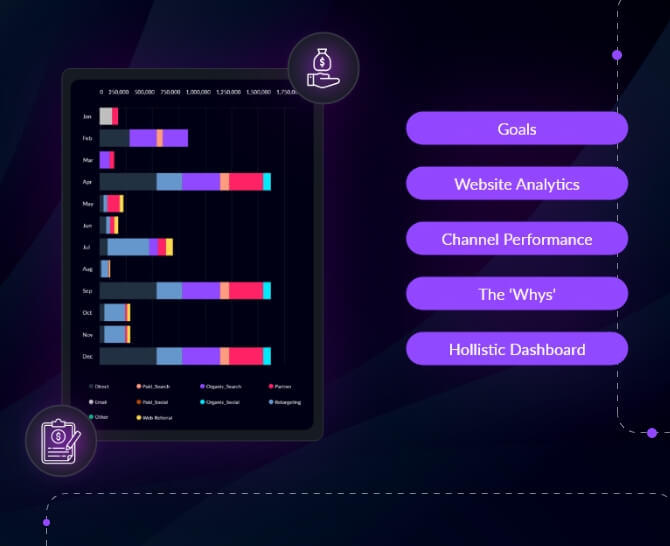
The Perfect Marketing Report: 5 Things to Include
For marketing leaders and the management to make sense of the results that the marketing department is yielding, they need access to succinct reports. With hundreds of metrics and KPIs, what to include in a marketing report becomes important.
With hundreds of metrics and KPIs, it could be overwhelming to decide what to include in an ideal marketing report so that it provides marketing leaders and the management with the info that matters to them. There are many things that need to be added to create a perfect marketing report. Let’s deep-dive into all of them. But first,
What is a Marketing Report?
The perfect marketing report provides a cross-section of your marketing efforts and a snapshot of your business. With statistics and feedback analysis, it helps you answer tough questions and check whether your marketing effort is going according to plan.
What Does it Tell?
A marketing report is a marketer’s friend that reminds them of their purpose when they’re lost and helps them justify their marketing expenses. In reiterating the aim and providing a justification, it serves as a compass and barometer of marketing success.
5 Things to Include in Your Marketing Report
1. Goals
Different people measure success differently. Your marketing report must begin with the goals you intend to reach, whether in terms of number of clicks, conversions, or whatever else you use as a metric for the success of your plan. For anyone reading your report, a recap of your marketing goals will provide an introduction to what you set out to do and set the expectation for what the rest of the report has in store. The goals also serve as a point of reference for how far you’ve come.
2. Holistic Marketing Dashboard
A good marketing report must include a holistic marketing dashboard that shows high-level information about different metrics and KPIs. It is immensely useful for giving not only an at-a-glance picture of the state of your marketing but also enables viewers to drill-down to specifics. Charts and graphs around deals won and closures, marketing influence on revenue etc. can add immense value.
3. Website Analytics
While a marketing dashboard provides a macro view of your marketing activities, it must also go into each segment and break it down. Websites are the platform closest to your product and the shortest path between a product and a consumer, much like the narrow road that leads into the driveway of a restaurant. It is essential to keep a close tab on this path and make sure it is unobstructed, well lit, attractive, well-labeled, and free of potholes and anything that will make for a bumpy ride.
One portion of the report should be dedicated to website analytics which contribute significantly to outreach, lead generation, and sales. The report should be able to account for these as well as variables like website traffic, click rate, bounce rate, average time spent on a page etc.
4. Channel Performance
A marketing report must dedicate a section to each marketing channel like paid, email, organic, social etc. The aim here is to not only measure the general performance of each channel vis-a-vis the spend, but also to deep-dive and understand the cost and the ROI associated with each channel. This will show which channels are working well and which ones aren’t. In separating the golden-egged geese from the money pit, you’ll be able to use the report to make important marketing trade offs.
5. The ‘Whys’
The most important part of a marketing report is the ‘whys’. It is imperative that you include an explanation of the numbers, KPIs, anomalies etc. instead of letting things hang. This is where the report starts to make sense and the insights become truly comprehensive. This portion explains what dashboards and charts say, and justifies the marketing decisions made therein. If something is not adding up in the numbers alone, this is the portion where it can be explained with the help of other associated variables.
Summing Up
The perfect marketing report is a matter of precision, brevity, and detail, containing insights from a sea of data compacted into smart data visualization and providing a holistic picture of all the efforts being made towards marketing. The report recapitulates marketing goals, justifies marketing decisions, and helps trace the path for the future of the plan.
Building this perfect report manually can be a task to reckon with, and it is much easier when you have the right tools to facilitate the collection, organization, and visualization of data across all your marketing channels and platforms. While manually, the report could be the result of weeks of toil, the right tool could practically make the report for you in a few minutes in just a few clicks.
DiGGrowth—an AI-driven no-code marketing intelligence platform—gives you the ability to justify your marketing spend by demonstrating the ROI of your marketing activities. Know how DiGGrowth can help you automate and generate custom marketing reports.
Ready to get started?
Increase your marketing ROI by 30% with custom dashboards & reports that present a clear picture of marketing effectiveness
Start Free Trial
Experience Premium Marketing Analytics At Budget-Friendly Pricing.

Learn how you can accurately measure return on marketing investment.
Additional Resources
The Future of Marketing: How Predictive Lead and Account Scoring is Changing the Game
Can we, in this incredible marketing landscape driven...
Read full post postCloud Wars: A Comparative Analysis of Leading Cloud Vendors
How many companies are using cloud computing? Around...
Read full post postContent Marketing Attribution: Tracking Content Impact Across the Customer Journey
So, you've poured your heart into crafting the...
Read full post postFrequently Asked Questions
The purpose of a marketing report is to provide a cross-section of your marketing efforts and offer a snapshot of your business. It helps answer important questions, evaluate the progress of your marketing activities, and justify marketing expenses.
The essential components to include in a marketing report are:
Goals: Start with a recap of the marketing goals you intend to achieve, providing an introduction to your objectives and setting expectations.
Holistic Marketing Dashboard: Include a high-level overview of different metrics and KPIs, allowing for an at-a-glance understanding of your marketing performance.
Website Analytics: Dedicate a section to website analytics, covering outreach, lead generation, sales, website traffic, click rate, bounce rate, and average time spent on a page.
Channel Performance: Devote a section to each marketing channel (paid, email, organic, social, etc.), assessing their overall performance, costs, and return on investment (ROI).
The 'Whys': Explain the numbers, KPIs, and any anomalies observed, providing insights and justifications for marketing decisions.
Including goals in a marketing report is important as it establishes a reference point for measuring success. By highlighting the objectives you set out to achieve, it helps track progress, evaluate performance, and align the report's content with your intended outcomes.
Website analytics should be included in a marketing report because websites play a crucial role in connecting products/services with consumers. Monitoring website performance metrics such as traffic, click rate, bounce rate, and time spent on pages provides insights into outreach, lead generation, and sales effectiveness.
Explaining the 'whys' in a marketing report is vital as it adds context and depth to the presented data. Providing explanations for numbers, KPIs, and anomalies helps stakeholders understand the insights and rationale behind marketing decisions. This section enhances the comprehensiveness of the report and supports data-driven decision-making.
 Manreet Khara
Manreet Khara 

